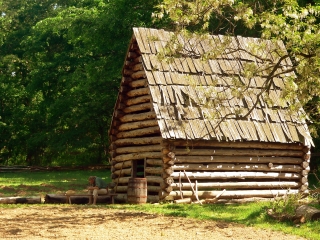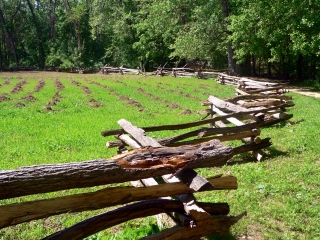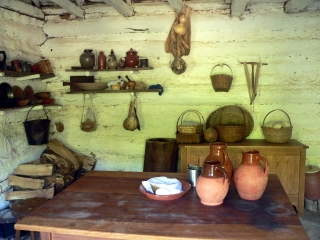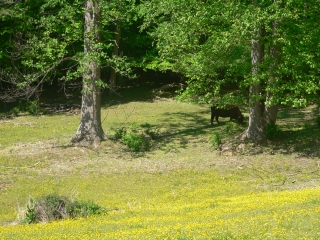NPS Website; Local Website
 WHAT IS IT?
WHAT IS IT?A living history museum that sends the visitor back in time to 1771. Permanently in-character costumed interpreters staff the one family, lower-class Virginia tobacco farm, till the fields and tend the turkeys, pigs and cattle.
BEAUTY (6/10)
A Park sign beckons you to “Step Back in Time” and “Follow this path to the year 1771”. Your imagination does not have to work that hard. The Colonial Farm is completely isolated from the outside world. Thick trees capture exterior mechanical noises and block sight lines in all directions. The costumed interpreters NEVER break character. We felt unnatural taking pictures. It is all just a little disconcerting.
The stellar building reproductions, wood fences and livestock pens enjoy a terribly realistic feel. The lifestyle was difficult and work intensive. We felt real-life empathy towards the family of 1771 tobacco farmers even after reminding ourselves that they are actors who return home at night and do not sleep in the ramshackle loft six-person-wide for warmth purposes.
HISTORICAL INTEREST (8/10)
The Claude Moore Farm examines the difficult life of a poor, single-family tobacco farm. This perspective is a welcome departure from the numerous 18th Century living history filthy rich plantation homes scattered throughout Virginia. The Commonwealth’s most popular historical attractions, Monticello, Mount Vernon, Colonial Williamsburg and Stratford Hall, leave the visitor to assume that the State consisted only of wealthy landowners who gained success through the feudal-era system of slave labor.
But this was not the case, either here or throughout the South. The hardscrabble, non-slave holding farmer was the overwhelming demographic rule rather than the exception. A visit to the Claude Moore Farm, while not glamorous or romantic, offers a more populist and typical glimpse into early American history than any high ceiling antebellum mansion.
 CROWDS (7/10)
CROWDS (7/10)We arrived at the Farm late Thursday afternoon after the crowds had left; Spring Thursdays bring large groups of schoolchildren.
During our stay, not only were we the only tourists but we were the only people not in colonial costumes. Our isolation enhanced the time travel experience but made us feel creepy and overtly voyeuristic.
EASE OF USE/ACCESS (4/5)
The route to the Claude Moore Colonial Farm elicits more than a few “Are you sure we’re going the right way?” moments even though the Site is very close to major thruways. Go east off Exit 13 of the DC Beltway (I-495) and onto the Georgetown Pike. In just 2½ miles, make a left turn onto Colonial Farm road.
The confusion sets in because Colonial Farm Road is also the entrance road to the George Bush Center for Intelligence a/k/a CIA Headquarters. The CIA land actually forms the Park’s heavily guarded eastern border. The Farm Visitor Center is a non-descript and poorly marked mobile classroom unit. A flimsy red and white homemade sign labeled Colonial Farm should point you into the gravel parking lot. (We missed the sign and continued to an indomitable CIA entrance a few hundred yards down the road where we turned around)
Your trip back in time and through the Park totals about one mile round trip. The gravel and dirt paths follow up and down a few gentle hills. The Site closes in the winter months, from late December through April 1 and opens during the remainder of the year only from Wednesday through Sunday. The Farm is also inaccessible via public transit.
CONCESSIONS/BOOKSTORE (5/5)
Exteriors can be deceiving. The Site’s mobile home Visitor Center is not much to look at, but it’s GateHouse Shop contains a wealth of unique museum reproductions, foodstuffs, games, candles, dishware and jewelry. The selection is reminiscent of the gorgeous items for sale at Colonial Williamsburg’s shops. The only difference is the GateHouse Shop’s price tags, which seem to slash Williamsburg’s prices by at least a third.
 COSTS (3/5)
COSTS (3/5)Admission is $3 per adult, $2 per child. Entry is free with the National Parks Pass. Most privately run affiliated NPS Sites do not honor the Pass. Thank you Claude Moore Colonial Farm! Upon entry, we also received a free six-person admission to the 18th Century Market Fair held May 20 and 21. You can download your own free pass here.
The Fair sounds fun: period crafts, food, games, dancing and goods. We might just travel back to DC, either next weekend or in July or October.
RANGER/GUIDE TO TOURIST RATIO (4/5)
Two of us and two Claude Moore family members, a brother and a sister. The rest of the clan was presumably running Colonial-era errands in Old Town Alexandria. Because the Park is an NPS affiliate site, there are no Rangers on staff. We would have enjoyed the intensive modern day historical perspective that NPS Park Rangers often provide.
TOURS/CLASSES (7/10)
Imagine traveling back in time to 1771. What would you have to say to a low income Virginia tobacco farmer? How would you relate? Well, we had nothing to talk about and very little in common. Our questions were answered with awkward non-sequiturs, pregnant pauses and worlds of difference.
Our probing felt condescending and forced. “Er, so, um, this tobacco farming is, um, really hard work, isn’t it...Well, um, thanks showing us your, um, nice (hovel) place, we’re going to (leave this crazy person and) look at your livestock. Have a nice day, er, (tirelessly) working your (unworkable) fields.”
Which is probably how it would have been. Life was a lot different 230 years ago. Unnerving, transportive immersion has its own educational advantages, the most powerful of which are the removal of nostalgia and the cruel understanding of how most 18th Century Americans lived.
FUN (7/10)
Our interaction with the aforementioned tobacco farmer’s 1771 sister was more productive and fun, but no less frustrating. Michael helped herd in her chickens while Gab remarked on her dried herbs and home’s glistening siding. We learned about the predatory foxes that stalk her poultry and the cold winter temperatures the family faces.
Michael next logical question was “How cold does it get?” Her response was:”As cold as it gets outside.” “No, what’s the temperature?” “What do you mean? It gets as cold in her as it does outside. We all have to sleep together to conserve warmth.” “No, what’s the temperature? How cold does it get?” “What do you mean? It gets as cold in her as it does outside,” she repeated with a probing look of wonderment.
Evidently, this family did not have had any understanding of measurable heat despite the thermometer’s invention in 1714. Most of our visit had this Abbott and Costello-routine feel. We had a much better time once we comprehended that the interpreters were NEVER breaking character. The day was beautiful, the wildflowers were blooming, the pigs were slopping around and we had happened onto a time-travel machine.
 WOULD WE RECOMMEND? (6/10)
WOULD WE RECOMMEND? (6/10)We would hold a much more effusive recommendation for the Claude Moore Farm if it were located anywhere else in the United States. It is cheap, fascinating, easy to get to, well staffed and profoundly revealing. But Washington DC offers the tourist so many free and wonderful museums, monuments and attractions, most of which are located either within walking distance of each other or near a subway stop.
The Farm is an obscure gem that is bound to be loved and appreciated by Northern Virginia residents and the most ardent of Colonial historians.
TOTAL 57/80
www.usa-c2c.com
© 2004-06